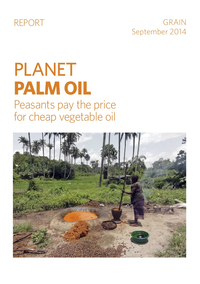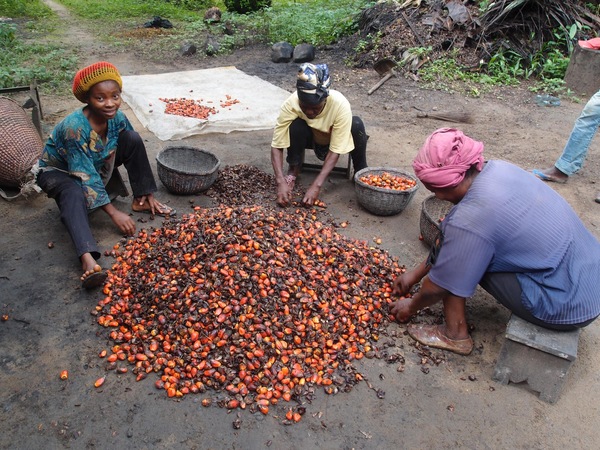Expanding production of cheap palm oil comes at a high price. Destruction of rainforests, labour exploitation, and brutal land grabbing: these are just a few of the nasty consequences that come with today's oil palm plantations.
With palm oil companies finding lands in Indonesia and Malaysia more difficult to acquire, attention is shifting to Africa. Over the past fifteen years, foreign companies have signed over 60 deals covering nearly 4 million hectares in central and western Africa for the development of oil palm plantations. The land grabs are already generating violent conflicts in several African countries.
 Download the full report
Download the full report
or click on the links below to read it chapter by chapter.
- Introduction
- Cheap oil
- Cash crop
- A scramble for lands
- Communities lose out to oil palm plantations
- New frontiers for oil palm
- A long history and vast biodiversity
- Oil palm production in West and Central Africa
- Well oiled resistance
- Land grabs for oil palm plantations in Africa and Papua
Palm oil is ubiquitous in our food systems. Look at the ingredients on any packaged food, and chances are you will find it there. Food companies love it, because it's cheap and abundant, so they use it whenever they can.
Demand is set to grow even further, as free trade agreements come on line that make it easier to import palm oil as a substitute for local animal or vegetable oils, as multinational food companies and supermarkets expand sales of of processed and packaged foods in the South, and as national mandates for biofuels, especially in Europe, create new markets for vegetable oils that indirectly increase demand for palm oil.
But it's not just demand that is driving the expansion. Oil palm plantations are a hot target for investors, whether from agribusiness, pension funds or corrupt tycoons looking for a safe and profitable way to launder funds. These days money is flowing into the bank accounts of palm oil companies, and they are using this cash to expand their land banks.
Producing all this cheap palm oil exacts a high price. Destruction of rainforests, labour exploitation, and brutal land grabbing: these are just a few of the nasty consequences that come with today's oil palm plantations. And, with growing demand, those consequences are spreading out to more parts of the planet.
The global expansion of oil palm plantations can only extend so far however. Since oil palms can only be cultivated economically in tropical areas near to the equator where there are high levels of rain fall, the global expansion of oil palm plantations is concentrated in certain parts of Asia, Africa and Latin America where these conditions exist. It so happens that these lands are occupied by peasants and indigenous peoples and the tropical forests that they depend on.
The expansion of oil palm plantations, therefore, is necessarily a story about the displacement of these people and the destruction of their forests and farms to make way for monoculture plantations.

This is on the verge of changing drastically. Over the past decade and a half, foreign companies have signed over 60 deals covering nearly 4 million hectares in central and western Africa for the development of oil palm plantations. The land grabs are already generating violent conflicts in several African countries.
The situation in Africa is a reminder that this brutal expansion of oil palm is not simply about land. It is about a larger struggle over food systems and models of development. Will African palm oil be produced by African peasants or multinational corporations? Will it be produced by peasants on mixed farms and semi-wild palm groves? Or will these peasants be displaced to make way for large scale, industrial plantations? These questions have implications beyond Africa. If the continent becomes a new frontier for low cost palm oil, exports from Africa will affect farmers growing vegetable oil crops in other countries, such as India and Mexico. There is therefore solidarity in the struggles of Cameroon peasants against oil palm plantations and the struggles of coconut farmers in India against palm oil imports. Solidarity is also to be found with the peasants of the Aguan Valley in Honduras, who are fighting against big landlords to stop the violent take over of their small oil palm farms and cooperatives that serve local markets.
This booklet is divided into two parts. The first part looks at the global expansion of oil palm plantations, and seeks to explain what are the main drivers behind the expansion, the mechanisms facilitating it and the areas being targeted. The second part looks at traditional oil palm production in west and central Africa, providing a very different model of a palm oil supply chain then the one being so heavily promoted by governments and corporations. The African model serves local food markets and is largely in the hands of rural women. Production is based on agroecological practices and biodiversity. The industrial plantation model, on the other hand, serves export markets and concentrates control and profits in the hands of the owners of large companies. It maximises profit by exploiting labour and the environment, and by grabbing lands and water from local communities.
This report also contains, as annexes, two tables. One provides information on over 60 large scale land grabs in Africa for oil palm plantations by foreign companies since 2000. The second covers land grabs for palm oil in the Papuas of Indonesia and Papua New Guinea.
Read on: Cheap oil